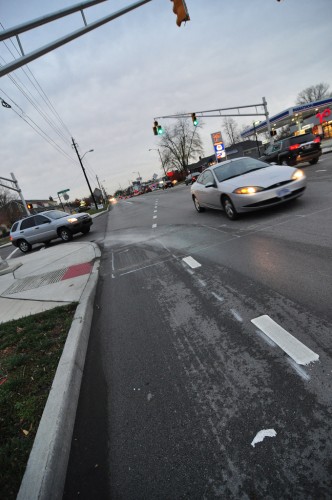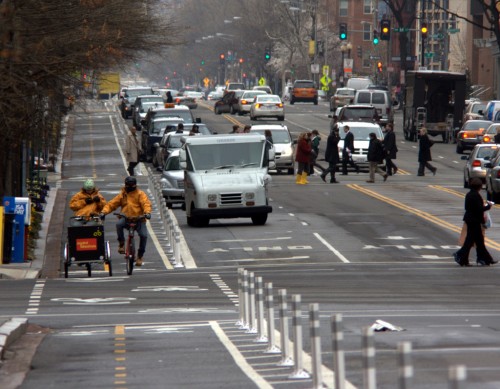The recent debate that has been raging here over the new bike lanes on Broad Ripple Avenue really touched off a fury of passionate debate among members of the urbanist community. On one side were folks (myself included) advocating for road diets to encourage slower traffic with the intended benefit being safer roads, sidewalks and a more equal travel corridor for all modes.

On the other side of the argument was the philosophy that mature neighborhoods such as the northside which have, over time, developed around corridors that encourage multiple auto travel lanes and in which the resulting built form has supported this use, should STAY this way; the notion being that people have come to expect this and that to change, could result in a loss of business, alienation of existing residents and ultimately, encouraging more flight to the suburbs and their nicer roads.

What we have here is a genuine debate about the future of our city and how we want our existing travel corridors to be shaped. One of our close friends Aaron Renn has long purported that cities should build themselves on a model that sets them apart from the suburb; that to try and beat them at their own game should not be attempted. According to Aaron,
“The best bet for the redevelopment of still hurting sections of downtown is to make sure they are selling something people want to buy – not ensuring that they have a huge parking lot. If we continue building surface parking lots, we will only have succeeded in building downtown replicas of suburban shopping malls, apartment complexes, and office parks which experience has shown (see Lazarus, Aryes, Sports, etc. as mentioned above) people are not willing to go out of their way to visit.”
This is just a small passage from a much larger examination of downtown parking lots and their affect on the regional market as a whole; however I think the reasoning can apply to modal shift and how it might be advantageous for a city to push it.
Is it fair to try to compete with the suburbs and their multi-lane boulevards that quickly shuttle people from their subdivisions to the mall? In the suburban environment, it makes plenty of sense since the built environment of sub-par interconnected neighborhoods requires fast roads to get people back and forth from their homes to shopping centers.
However, our old urban neighborhoods look much different. Grid patterns traverse the Old Indianapolis area and provide a level of connectivity that the suburbs cannot compete with. Leveraging this asset and providing transit that serves a larger range of people can deliver an advantage that the suburban built form cannot. I would like to think that this builds off of Kevin’s recent post discussing an urban cure to the ills that oil dependence brings with it.
In conclusion, if cities wish to create a vibrant city for people to move back to, pushing mode share change in the form of more robust transit ridership and safe streets for cyclists and pedestrians is a vital tactic in getting there .
Curt, it is precisely because of the old city’s connectivity that I argue against traffic choking on its arterials.
.
It is seldom necessary in the “Old Indianapolis” parts of Marion County for cyclists and pedestrians to use a big arterial for more than a block or two. Broad Ripple offers a perfect example: Kessler Blvd and BR Ave are each have a number of low-traffic parallel streets (58th, 60th, 61st) that are comfortable for family cycling and walking.
.
Further, my arguments against urban traffic choking have not been about trips to the mall. The truth is that we are almost all mostly car-dependent for trips to daycare, work, and groceries. To the extent that we make those into time sinks (and increase fuel consumption/pollution due to more stop/start/idle cycles) we decrease the desirability of city living.
.
I recently changed jobs. It takes me the same amount of time to drive 7.4 miles to Lawrence (mostly on secondary arterials such as Pleasant Run Pkwy, Ritter, and Mass Ave) as it does to drive under 6 miles to 16th & Meridian. I was shocked to discover this; I gave up on the interstate after two days, wiling to “pay” 5 more minutes for calm passage. No trade.
.
This is what I meant on the “Urban Living as Antidote” thread: one is not far (in time) from any job in Marion County if one lives in Center Twp…as long as our arterials do their circulatory job. Think: what happens to people when our arteries narrow and we don’t have a bypass?
There are now rumblings the southside I65/I465 interchange will be rebuilt, and another lane added I465.
More billions poured into expanding the highways instead of mass transit.
Suppose those dollars went into creative ways to get the commuters to their southerly destinations (such as park-and-ride facilities) instead of making it more attractive for more drivers to fill the updated interchange with still more vehicles in another 10 years — and thus repeating the cycle?
I always thought the ‘interstate’ system should be designed to handle the continuous flow of interstate traffic and not be designed to handle peak traffic from commuters for an hour in the AM and in the PM.
“and in which the resulting built form has supported this use, should STAY this way; the notion being that people have come to expect this and that to change, could result in a loss of business, alienation of existing residents and ultimately, encouraging more flight to the suburbs and their nicer roads.”
This eerily sounds like it could have been written in 1961, advocating for the continuation of segregationist policies. My point is that just because something was built that way and would cause some initial distress, doesn’t mean that it has to stay that way. When something (or someone) has received an unfair advantage from the beginning, you take steps to level the field.
I think you might be missing Curt’s point here. He’s not arguing this, but he says there are people that do.
That second picture. That would solve a lot of problems. I’ve often thought as part of our education in this city about sharing the roadways – why don’t they put up the rubber posts like DC has? I can’t tell you how many people on Lafayette Rd and others have tried to inch past me on the right (IN THE BIKE LANE) to turn right, when I’m following the law and staying outside the bike lane till the intersection, looking then turning.
These simple posts in some of the more congested and confusing areas to turn right in front of a bike lane would educate the population immensely. Bikers don’t want killed and drivers don’t want scuffs and scrapes on their car from the white posts.
Why can’t we installs those. Yes, theyll get run over and look bad, but for a few years they will serve a good educational purpose. I’m not a biker, I’m a driver, but fully support the bike paths and people to STAY IN THE WHITE LINES.
Which comes first for Indy to develop into a more urban area: road sharing infrastructure? Denser development? Corporate / big business development? Small business / live-work incentives and development? Public transportation? Sports & Conventions? Suburban expansion? Continued highway expansion? What should be the next step to shape Indy in the next 5 years?
It has to be an updated comprehensive landuse policy. We need a complete reversal on planning in general. Indy still takes the same seperated approach. Developers need to be rewarded for providing better development. When you have to jump through hoops for less parking, taller buildings, and denser development….you tend to stay the course. It should cost money to exceed parking maximums, FAR minimums and height minimums. A public hearing and fight about reducing off street parking spaces can cost money and delay a project by months if not completely.
Pardon my ignorance on the matter, but where does a change in land use policy begin and how can a person like myself help make the city more connected and less dependent on auto travel and huge parking lots?
The city is currently undertaking a process of this nature. It is called indy rezone. you can find more information here: http://www.indy.gov/eGov/City/DMD/Planning/Projects/Pages/IndyRezone.aspx